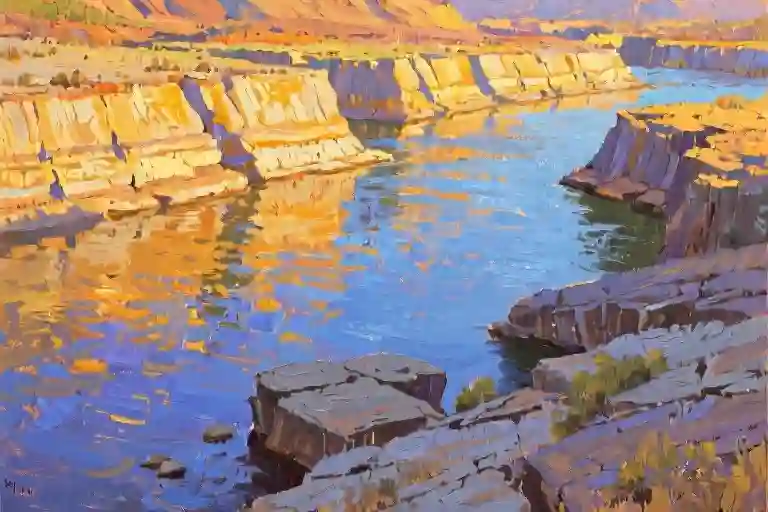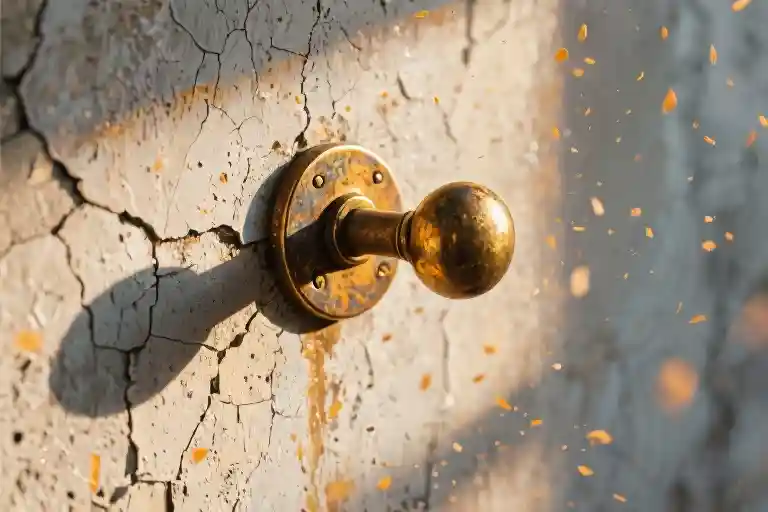Norman Maclean’s words linger like the river he describes: “Eventually, all things merge into one, and a river runs through it.” There’s something about that image—the way water shapes rock, how time etches itself into the landscape—that feels intimately connected to how we learn to see the world through art. It starts simply, as most profound things do. As children, we pick up crayons and reduce the universe to its geometric essentials: triangular trees, square houses, round suns floating in a corner of the page. The world, in those early years, is a collection of shapes waiting to be colored in.
This isn’t just child’s play. Those crude drawings are our first attempts to make sense of light and form, to translate the three-dimensional chaos around us into something our hands can reproduce. What’s fascinating isn’t the inaccuracy of those childhood sketches, but the instinctive logic behind them. A dog isn’t a furry mass of shadows and contours—it’s an oval with sticks for legs. A face isn’t a shifting interplay of highlights and planes—it’s a circle with dots and a curve. We’re not drawing what we see; we’re drawing what we understand.
Somewhere along the way, though, that changes. If you keep drawing into adulthood—or even just keep looking—you begin to notice how rarely things appear as their “true” shapes. A tree isn’t a triangle but a fractured silhouette against the sky, its edges blurred by leaves moving in the wind. A face is rarely perfectly oval; it’s a collection of asymmetries, with one side often swallowed by shadow. The world stops being a coloring book and starts being a puzzle of light.
This shift from shape-thinking to shadow-seeing is where art becomes more than imitation. It’s why Maclean’s river metaphor resonates: just as water reveals the contours of the rocks it flows over, light reveals the truth of the forms it touches. Those “timeless raindrops” on the rocks? They’re not unlike the highlights in a charcoal drawing—fleeting, but essential for understanding depth. The words under the rocks? Perhaps they’re the unspoken rules of perception we uncover only by looking closely.
What’s haunting about this process isn’t just the technical challenge of rendering light accurately. It’s the realization that seeing—truly seeing—requires surrendering our early, comfortable certainties. The square house must crumble into planes of brick and mortar. The oval dog must dissolve into a tangle of fur and muscle. And somewhere in that dissolution, we find a deeper truth: that art, like a river, is never finished. It keeps carving new channels through the bedrock of what we think we know.
The Child’s Artistic Intuition: A World Built from Shapes
We all remember those first crude drawings from childhood – the lopsided houses with square walls and triangular roofs, the stick-figure families with circular heads floating above rectangular torsos. This geometric simplification isn’t just a limitation of motor skills; it reveals how children cognitively process visual information. Their minds instinctively reduce complex forms to essential shapes, creating a visual vocabulary of circles, squares, and triangles that serves as the foundation for artistic perception development.
Watch any preschooler draw a tree, and you’ll witness this shape-based thinking in action. The trunk becomes a brown rectangle, the foliage a green scribbled circle – not because they can’t see the intricate branching patterns or varied leaf shapes, but because their developing brains prioritize symbolic representation over realistic detail. This phenomenon explains why children’s drawings from different cultures share striking similarities; the language of basic shapes transcends geographical boundaries.
In my niece’s kindergarten artwork currently taped to my refrigerator, I see this universal visual grammar at work. Her self-portrait consists of a yellow circle (head) atop a red rectangle (dress), with four brown lines extending from the torso (arms and legs). The eyes are two blue dots floating in the middle of the face, the mouth a curved black line hovering below them. What’s fascinating isn’t the absence of realistic features, but how effectively these simplified shapes communicate the concept of “a girl” through pure visual symbolism.
This shape-based approach to drawing serves several crucial developmental purposes. First, it allows young artists to experience immediate success – anyone can draw a recognizable house using simple geometric forms. Second, it builds confidence by providing clear parameters (“make four equal lines for walls”) rather than overwhelming children with the infinite complexity of real-world appearances. Most importantly, this stage establishes the fundamental connection between observation and representation that will later evolve into more sophisticated artistic perception.
As adults looking back, we might dismiss these childish drawings as primitive or inaccurate. But in doing so, we overlook their profound wisdom. That kindergarten drawing on my fridge captures something essential about human perception – our minds naturally seek patterns and reduce chaos to comprehensible forms. The child’s instinct to draw “what they know” rather than “what they see” reveals how all art begins as an act of cognitive organization before it becomes an exercise in visual fidelity.
This early shape-based thinking forms the foundation for all subsequent artistic development. Before we can render subtle gradations of light and shadow, we must first understand how objects occupy space through their basic forms. Those childhood trees made of triangles and circles contain the seeds of later understanding – that even the most complex subjects can be broken down into fundamental components. The transition from shape-thinking to light-perception isn’t a rejection of this initial approach, but rather its natural evolution, like a river carving deeper channels through familiar terrain.
The Adult’s Philosophy of Light: What Shadows Reveal
The shift from seeing the world as flat shapes to understanding it through light and shadow is less like learning a new technique and more like gaining a new sense. Where a child draws a circle for a head and two dots for eyes, an adult begins to notice how the left side of that face disappears into darkness under afternoon light, how the curve of a cheekbone fractures into planes of gray. This isn’t progress—it’s metamorphosis.
Leonardo da Vinci’s notebooks obsess over this. His sketches of draped fabric show folds not as lines but as gradations, where shadow becomes the primary storyteller. In his Treatise on Painting, he writes about chasing twilight in the streets of Florence, watching how fading light makes solid things ambiguous. Centuries later, Rembrandt would take this further—his self-portraits aren’t portraits of a face but studies of how time and grief manifest as pockets of darkness under eyes, as golden light clinging to the ridge of a nose. What makes these works unsettling isn’t their realism but their honesty: they acknowledge that we’re never fully visible, not even to ourselves.
This explains why beginner artists often resist shading. Filling in a cartoon sun is joyful; rendering the way that same sunlight leaves half a coffee cup in obscurity feels like betrayal. There’s vulnerability in admitting that most of what we see is inference rather than fact. Shadows remind us that every observation is partial, that the backside of the mug exists only because we’ve held one before. Japanese ink painters understood this intuitively—their sumi-e landscapes use absence as actively as presence, letting blank paper suggest mist or distance.
Try this tonight: place an apple on your kitchen table and turn off all lights but one. Watch how the shadow isn’t just darker apple—it’s a distorted version, stretched long by the angle of light. That elongation contains information about the time of evening, about the height of your lamp, about the space between objects we usually ignore. Photographer Hiroshi Sugimoto’s seascapes capture this perfectly—his horizons divide each frame into subtly different grays, proving that ’empty’ space teems with visual incident if we learn to read it.
What children’s shape-drawings and masters’ chiaroscuro share is the same starting point: both reduce complexity to grasp it. The difference lies in what they deem essential. Where a six-year-old simplifies a tree to a green circle on brown stick, Edward Hopper simplified a diner to intersecting planes of artificial light and synthetic shadows. Neither approach is ‘correct,’ but the latter acknowledges something vital—that light doesn’t just illuminate reality; it edits it.
Caravaggio took this editing to extremes. In The Calling of Saint Matthew, the divine isn’t represented by angels or halos but by a diagonal shaft of window light cutting through tavern gloom. The shadows here aren’t lack of illumination—they’re active participants, pushing figures forward or swallowing them whole. Modern comic artists like Frank Miller use similar tactics—in Sin City, shadows don’t follow anatomy; they impose meaning, turning a trench coat into a black wedge of moral ambiguity.
This is why learning to draw shadows feels existential. It requires admitting that our most basic perceptions are negotiations between what’s there and what our brain insists should be there. Neurologists confirm this—nearly 40% of our visual cortex dedicates itself to edge detection, to deciding where one thing ends and another begins. Every artist’s struggle with proportion is really a struggle with this biological compromise.
Practical exercise: For one week, draw only shadows. Not objects—just the shapes their absences make. You’ll notice how morning shadows have crisp edges while afternoon shadows bleed, how a shadow’s color changes based on surface (blue-gray on white walls, yellow-brown on wooden floors). This trains something deeper than technique—it trains humility before the world’s unmanageable complexity. As painter Richard Diebenkorn advised: ‘Always have something in your painting the viewer won’t understand immediately.’ Shadows are that something.
What emerges isn’t just better art but a revised relationship with reality. Light becomes less a tool and more a collaborator, one that—like Norman Maclean’s river—carves canyons through the bedrock of our assumptions. Those ‘rocks from the basement of time’ might be the stubborn ways we insist on seeing; the ‘timeless raindrops,’ the moments when light shows us otherwise.
The Timeless Metaphor: Rivers and the Art of Time
The river doesn’t ask permission to carve its path. It simply moves, wearing down ancient rocks with patient persistence, carrying fragments of distant mountains to unknown shores. Norman Maclean’s words about rocks from the basement of time have stayed with me like the afterimage of bright light – that peculiar way shadows linger behind your eyelids after you’ve stared at something luminous for too long.
Artists have always wrestled with time. Van Gogh’s Starry Night swirls with temporal anxiety, those thick brushstrokes capturing not just stars but the very act of seeing them. The cypress tree reaches upward like fingers trying to grasp something fleeting, while the village below sleeps unaware of the cosmic drama overhead. It’s all there – the human struggle against impermanence, painted with such urgency that the pigments seem still wet after a century.
What fascinates me is how natural elements become our allies in this struggle. Water especially. A single raindrop means nothing, but count enough of them and you get canyons. That’s the secret Maclean understood when he wrote of timeless raindrops on ancient rocks. The river’s work is slow but inevitable, much like how artistic perception develops – through countless small realizations that eventually cut channels deep enough to change your entire landscape.
Practical Alchemy: Turning Time Into Texture
Try this tomorrow morning with your coffee:
- Watch how steam rises in fragile columns, dissolving before reaching the ceiling
- Notice the liquid’s surface tension holding together until that first sip breaks it
- Sketch just the shadows cast by your cup, not the object itself
These mundane moments contain entire philosophies. When you draw moving water, you’re not really drawing water at all – you’re drawing light’s relationship with a surface that won’t hold still. The shimmering reflection on a pond is time made visible, a perfect metaphor for artistic perception where nothing stays fixed long enough to pin down.
Georgia O’Keeffe painted bones bleached by sun and time, turning them into monuments rather than relics. Andrew Wyeth’s Christina’s World makes grass whisper with seasonal change. These artists didn’t just depict nature – they collaborated with time itself, letting erosion and growth become co-authors of their work.
Perhaps that’s why Maclean’s river haunts so persistently. It reminds us that every mark we make is simultaneously permanent and fleeting – as solid as bedrock, as transient as a raindrop. The rocks remain, but the water shaping them never touches the same stone twice.
The Practical Bridge: Three Steps from Shapes to Shadows
Artistic perception development isn’t about talent—it’s about retraining your eyes to see differently. That childhood ability to reduce the world to triangles and squares never disappears; it simply needs upgrading for adult vision. Here’s how to rebuild your observational skills through deliberate practice.
Step 1: Geometric Reduction Method
Start with the coffee mug on your desk. Before drawing its curved handle, identify the hidden rectangles in its cylindrical body. This geometric approach mirrors how children instinctively see but with intentionality. Try this exercise:
- Choose any household object (a chair, teapot, or your own hand)
- Sketch only its underlying shapes—ovals for finger joints, trapezoids for chair legs
- Resist adding details for five full minutes
“We don’t draw objects, we draw the shapes between them,” my first life-drawing instructor would say. This foundational step in observational drawing techniques teaches spatial relationships before light complicates the equation.
Step 2: The 9:00/15:00 Shadow Experiment
Light and shadow in art reveal what shapes conceal. Each morning and afternoon for one week:
- Place an apple (or any small object) near a window
- At 9 AM, quickly sketch its shadows with parallel lines
- At 3 PM, redraw the same apple from the same angle
- Compare how the changing light alters its perceived form
You’ll notice how morning shadows stretch sideways like taffy while afternoon ones compress beneath objects. These studies aren’t about creating finished artwork—they’re about noticing how illumination sculpts reality differently than outlines suggest.
Step 3: Creating ‘River Memory’ Sketches
Now combine both methods using Norman Maclean’s water metaphor. On a large sheet:
- At the top, draw a landscape using only geometric shapes (triangular mountains, rectangular buildings)
- In the middle section, add mid-day shadows with crisp edges
- At the bottom, let shadows dissolve into wavy lines like flowing water
This progression physically demonstrates how artistic perception evolves—from solid forms to fluid impressions. The most interesting transitions happen where hard shapes meet soft shadows, much like riverbanks eroding over time.
Keep these practice sessions short (15-20 minutes) but consistent. The goal isn’t mastery but developing what artists call “shadow vision”—that moment when you stop seeing objects and start noticing how light defines their existence. Your childhood triangle trees weren’t wrong; they were just waiting for their shadows to appear.
The River’s Whisper: Where Art Meets Time
The water stains on old sketchbooks never bothered me. They warped the paper, yes, but also left behind traces like the rings inside a tree trunk—evidence of creative monsoons and dry spells. Norman Maclean was right about being haunted by waters. Every artist carries their own river inside, one that begins as a child’s straight blue line across paper and gradually deepens into something capable of carving through the bedrock of time.
That first blue line we draw as children—the one meant to be a river—holds more truth than we realize. It starts stiff and certain, like the square houses and triangular trees we construct around it. There’s comfort in those clean angles, in the way crayon colors stay obediently within the lines. But rivers in nature never follow straight paths, just as light refuses to respect the boundaries we assign to objects. Somewhere between childhood and now, we learn to see the wrinkles in reality.
Perhaps you remember the exact moment your river changed course. For me, it was a September afternoon watching oak shadows stretch across my drawing pad. The tree itself was predictable—brown trunk, green oval top—but its shadow kept shapeshifting. Darker here where leaves clustered, nearly transparent there where afternoon light filtered through. That’s when I understood why Renaissance masters obsessed over chiaroscuro. Shadows aren’t just absence; they’re light’s quiet confession about form.
This is what separates symbolic art from observational art. Children draw what they know (a face has two eyes, therefore show both). Adults learn to draw what they see (maybe only one eye catches the light). The transition feels like losing religion—those comforting certainties about how things ‘should’ look replaced by the thrilling uncertainty of how they actually appear. It’s unsettling. Liberating. Like watching your childhood river flood its banks and carve a new delta.
Maclean’s rocks from the ‘basement of time’ might be the hardest lesson. As artists, we want to capture permanence, but our subjects insist on changing with the light. That vase you sketched at dawn becomes a different shape by noon. The solution isn’t to chase perfect representation, but to leave evidence of time’s passage—a deliberate stroke showing where shadow crept across the tablecloth, a smudge where your hand moved with the sun.
So here’s your invitation: tomorrow, track a single shadow. Not to master it, but to witness its journey. The one your coffee mug makes at breakfast will have migrated by lunch, grown legs by afternoon tea. Sketch just the shadow (not the object casting it) at three different hours. Notice how its edges soften or sharpen, how its darkness fluctuates like tide marks. These are time’s fingerprints.
Rivers don’t flow in straight lines. Neither does artistic growth. Those bends where the current doubles back on itself—the frustrating plateaus, the sudden leaps—they’re all part of carving canyons. Keep your pencil moving. The rocks remember every stroke.





